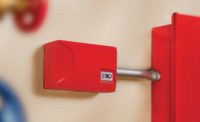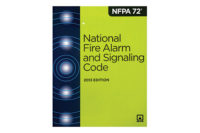Adhering to changes in fire code on a local basis is not a choice — it’s a “shall,” not a “should.”
Although code compliance hinges on local ordinances enacted by cities, townships, counties, and even state government, the process begins with the development of standards by organizations such as the National Fire Protection Association (NFPA) of Quincy, Mass.; Underwriters Laboratories (UL) of Northbrook, Ill.; and International Code Council (ICC) of Washington, D.C.
NFPA 72 is the guidebook that fire protection professionals follow when installing smoke detectors, manual pull stations, notification appliances, and other devices. For this reason, our focus for the remainder of this story will be on NFPA 72, with minor attention to UL.
Why It’s Important to Follow Established Fire Code
For those who refuse to follow the codes set forth by these code-making bodies, the financial penalty can be significant, not to mention the revocation of individual and company state fire licenses. But this is not where it ends. Because this now unlicensed company that failed to follow code is no longer permitted to correct the non-compliant infraction(s) or finish the installation, it may now be faced with paying a licensed fire alarm company to fix the violation(s) and complete the contract.
The preemptive solution to this is clear: know the codes and follow them to a “T.” That means investing in code books, and sometimes state-level code documents that often include slight alterations to NFPA codes. Another option is education, videos, and online study courses. Remember, a fire code like NFPA 72 provides the minimum standard by which to go by when working with local plans examiners, inspection officials, and feet-on-the-ground fire inspectors. Without a fundamental knowledge of the legislative code sets associated with the jurisdiction you’re in, how can you expect to pass a final inspection?
IP-Based Communications Preferred Over POTS
There were several changes in the 2016 Edition of NFPA 72 that some fire alarm installers either missed, believed not to be important, or their local jurisdiction deemed unacceptable. One of them is the use of performance-based, IP-oriented communications over that of traditional Plain Old Telephone System (POTS).
Charles Aulner, president of National Training Center Inc (NTC) of North Las Vegas, Nev., adds that one of the things NTC runs into in the field is technicians and companies that continue to use two conventional telephone phone lines simply because it’s what they've always done, even though the code has changed. “Obviously, the practice in the industry is slower to change than the code is,” Aulner adds.
Because of this, the fire alarm industry, including the various fire codes, now embrace what’s commonly referred to as “performance-based communication technologies, such as cellular and the internet, both of which involve IP (Internet Protocol) communications, which is actually now more reliable than today’s hardline POTS.
“I’ll take cell phone over hardwire phone lines any day because phone companies are not maintaining them,” says Nick Markowitz, owner of Markowitz Electric & Integration of Verona, Pa. “They’ve allowed the whole network to deteriorate. So my first choice is cellular. In fact, a lot of my fire alarms — where I can do it — have internet with cell backup. Now they have the new M2M (machine-to-machine) that have both AT&T and Verizon SIM cards. You’re almost guaranteed coverage where you have internet and access to two different cellular systems.”
Changes in Smoke Detection Products
According to Richard Roux, NFPA 72 staff liaison with National Fire Protection Association, one of the changes that took place in the 2019 Edition of NFPA 72 involves residential smoke alarms and smoke detectors. Residential smoke alarms, for example, must be able to detect the difference between smoke created during routine cooking and that of other more serious sources.
“The new standard for smoke detectors has continually been pushed back,” says Chris Miers, regional marketing manager with Bosch Security and Safety Systems, Fairport, N.Y. “The changes in this edition standard are major in scope, most notably of which are the addition of three new fire tests: detection of flaming polyurethane foam; detection of smoldering polyurethane foam; and reduction of nuisance alarms. As a result of this, substantial changes have to be engineered to detector construction both inside and out.”
Miers adds that these changes include air flow, smoke chamber size and shape, sensing technology, and firmware algorithm updates. With the strict code changes for smoke detectors coming, every manufacturer will need to be compliant.
In order to make all of this happen, UL has changed a lot of their rules relative to the detection ability of these detectors. Thus, traditional photoelectric and ionization detectors must pass a new flame and cooking test, and, of course, they’re not passing them without the use of additional sensors. Although the concept of multi-criteria detection isn’t new, manufacturers are now required to change their designs in order to comply with the new code. And so, NFPA 72 and the product standards enacted by UL for listing purposes go hand-in-hand.
Adoption Often Lags Current NFPA 72 Editions
If you work on sizable fire alarm installations, then you already know that most of the time communities have their own ordinances that are based on specific editions of NFPA 101 (Life Safety), 72 (Signaling Code), 70 (Electrical), 13 (Sprinkler), etc. Most of these communities, if not all, rarely catch up to the current edition.
According to Todd Domer, director of engineered systems with Gene Ptacek and Son Fire Equipment Co. Inc., Cleveland, many cities and even states are one cycle behind on using the latest code, such as NFPA 72, because they want to see how the code changes will affect them locally.
“It’s important to note that even though NFPA 72 is updated on a three-year schedule, each state determines which edition of the code they will enforce in their jurisdiction. In most states the legislative process is slow, so the edition of the code that is enforced is typically not the most current edition. It is common for states to be a code cycle or two behind the most current one,” Domer says.
Changes in the Upcoming NFPA 72 2022 Edition
There are four areas where significant changes will take place in the NFPA 72 2022 Edition: cybersecurity, color-coded tagging, remote access, and survivability.
1. Addressing the need for cybersecurity: According to NFPA’s Roux, “The requirements for cybersecurity, which is rather brief, is contained in Chapter 11 of the upcoming 2022 Edition. There isn’t a lot of meat to it, and it basically says that cybersecurity shall be provided where required by building codes, the AHJ, specific projects, and things like that.”
Jon Hughes, vice president of marketing and product strategy with Edwards/Kidde Systems of Bradenton, Fla., says that an outgrowth of current NFPA 72, Chapter 24, dealing with risk analyses of emergency communication systems acknowledges the vulnerabilities to products such as fire panels, which establish connectivity with outside networks, and aims to provide direction to the industry working to help assure their products can’t be used by bad actors as points of entry to building networks.
2. Color-coded tagging for fire panels: A lot of states already have some kind of color tagging system in place. But now a special section of the new code will include specific information that relates to the what, where, when, and why behind it.
“We’ve added an annex on color tagging fire alarm systems — green, yellow, and red,” Roux says. “Where the system is operational, you'll have a green tag displayed on the face of the panel. And of course, if the system is questionable or slightly impaired, it will have a yellow tag. If the system is to the point where it doesn’t work and a fire watch is required, it will have a red tag.”
Code Changes in Notification Devices
One of the changes that is already in place, having occurred in the current 2019 edition of NFPA 72, is that of LED notification appliances. For decades the industry has utilized Xenon technology with regard to the generation of attention-getting light pulses emitted by a typical notification appliance.
“Light pulse characteristics for these devices are defined by the National Fire Protection Association in NFPA 72 National Fire Alarm and Signaling Code,” says Paul Dorion, senior engineer with Mircom Group of Companies, Montreal. “The 2016 edition updated the light pulse characteristics. The flash rate falls between 0.5 sec, and 1 sec. The light pulse duration was reduced from 200 milliseconds to 20 milliseconds.
Dorion says, as part of the listing process, UL 1971 covers the light pulse duration. “The standard went through a revision in 2018. The signal strength and format were updated. All flash pulses that fall between 20 milliseconds and the previous 200 milliseconds will have their candela output de-rated proportionally to the pulse width. The standard introduces a new table (27.4) for that effect.”
The compliance date associated with UL 1971 is scheduled for later this year.
3.Remote access over cellular/internet: In years past, when a significant change has taken place in the system, it’s necessary to retest the system, and that’s still the case. Also, where changes involve panel programming, this work must be performed on site. Someone must be there, at the location to retest and assure that all is well. But now, thanks to a specific change in the upcoming 2022 Edition of NFPA 72, remote access is allowed — but ONLY where it comes to updating the firmware/software in the fire alarm panel. System programming and any necessary retesting must be done on site.
“It’s counterintuitive to cybersecurity, but nevertheless it’s in the upcoming code,” Roux says. “So this means that a company, an organization, a technician, an owner can do stuff with their fire alarm system from a remote location. They’ll have a program of sorts to do it with, probably through the cloud, where they will log in, establish their credentials, and then they can reset, silence, perform remote diagnostics and update software.”
4.Power Limited Cable Survivability: According to Roux, for those who install fire alarm systems, changes in NFPA 72 in this regard pertain to cable survivability. In most buildings, when any alarm-initiating widget activates, it activates all the speakers, horns, and strobe lights in the building. In particularly difficult buildings, such as high rises, huge horizontal complexes, or a hospital where they relocate people when there’s a fire alarm, it’s no longer a general alarm.
“This commonly requires a two-hour rated assembly; and wherever these wires pass from the control panel to the horns on the 8th floor, for example, that wire must be protected in a more robust manner [than is customary], and so we call this ‘survivability,’” Roux says. “This has always involved a two-hour rated cable or raceway of some kind, but now the committee has seen fit to reduce it in some occupancies to a one-hour rating.”
Whether a code change involves the 2016, 2019, or the upcoming 2022 Edition, always check with your local AHJ, code official, or inspector to find out which edition of the code that your community uses. In some cases, like Ohio, there’s a separate set of ordinances — in this case called the Ohio Building Code (OBC) — that provide details on what you can and cannot do. Double check before you send your blueprints to the local plans examiner, and certainly before you drill a single hole.
Inclusion of Bi-Directional Amplifiers in NFPA & UL
Ask a firefighter or a police officer what it’s like to enter a large structure and have their radios not work and I’m sure they’ll tell you it’s not fun. A conversation regarding this issue began after 9/11. The main lesson learned from that tragic event involved the difficulties that first responders had when they responded to calls for help. The result of that was further conversations among standard-making bodies with regards to the inclusion of bi-directional amplifiers in subsequent NFPA and UL standards and codes.
“The technology is referred to as bi-directional amplifiers because they amplify the signals going into and coming out of large buildings,” says Jason Webb, director of industry affairs with Potter Signal, St. Louis. From a codification perspective, that’s what was needed in order for first responders to do their jobs as safely and effectively as possible. Initially the code requirements were pretty cut and dried — simply stating that building owners must build them in such a manner that first responders can easily communicate using their own radio equipment.”
Today, UL and NFPA require that new buildings be equipped with a means of assuring first responder communication when they’re performing their duties within the confines of almost any sizable structure. These bi-directional amplifiers are designed to do just that, and you can find out more in Chapter 18 of NFPA 1225, “In-Building Emergency Responder Communication Enhancement System,” as well as UL 2524. Webb says that the new code requires bi-directional amplifiers to be UL listed just like any other fire-related device.







